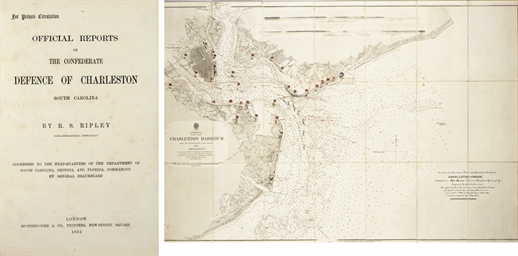FORT SUMTER]. RIPLEY, R. S. Autograph letter signed ("R. S. Ripley, Lt. Col. Art. Comdg.") to Col. Edward Manigault, Head Quarters, Fort Moultrie, 9 April 1861. 1 page, 4to, blue paper , Fine. THREE DAYS BEFORE SUMTER, COL. RIPLEY NERVOUSLY AWAITS THE UNION RELIEF CONVOY: "THE LARGE FLEET IS NOT YET IN SIGHT" A DRAMATIC LETTER FROM CHARLESTON HARBOR, FROM A FAMED REBEL ARTILLERY OFFICER. "The breach sights are right in the base ring," Ripley writes, "but all wrong in the gradation for our guns. They are all of 1829 or thereabouts, an entirely different model from the gun referred to in the Ordnance Manual. They'll do. Would it be possible to make a few to run up to about 7 in. or even higher in a day or so. The large fleet is not yet in sight." The complex of forts in Charleston Harbor had been the site of dramatic action ever since December 1860, when South Carolina bolted from the Union. On 26 December 1860, the Union commander, Major Anderson, fearing an assault, abandoned Fort Moultrie and moved his headquarters over to Fort Sumter. In early January the rebels seized Moultrie and Fort Pinckney, and also took the Federal arsenal in Charleston. In January, a supply ship, the Star of the North , came into the Harbor, only to ignominiously turn and flee when Confederate guns opened fire on her. Lame duck President Buchanan, desperate to avoid war, let this outrage pass, content to allow the status quo to continue until Abraham Lincoln took office. Lincoln did not make any decision to resupply the fort until the first days of April 1861. He informed Governor Pickens that only food and supplies were on the way, and that no guns and men would be thrown in. Davis had his new overall Confederate commander in the Harbor, General P. G. T. Beauregard, issue an ultimatum to Anderson on 11 April, which the Union officer rejected. The next day, when the Union relief convoy appeared at the mouth of the Harbor, Beuaregard issued one last ultimatum, and then commenced shelling Sumter at 4:30 a.m. on 12 April 1861. The cannon that launched the first shots came from Fort Johnson on James Island, but Ripley's batteries on Sullivan's Island soon joined the fray, pounding the Union garrison for 34-straight hours, until the massive destruction to the walls and fires inside made further resistance futile. The American flag came down and four years of brutal fighting began in earnest.
FORT SUMTER]. RIPLEY, R. S. Autograph letter signed ("R. S. Ripley, Lt. Col. Art. Comdg.") to Col. Edward Manigault, Head Quarters, Fort Moultrie, 9 April 1861. 1 page, 4to, blue paper , Fine. THREE DAYS BEFORE SUMTER, COL. RIPLEY NERVOUSLY AWAITS THE UNION RELIEF CONVOY: "THE LARGE FLEET IS NOT YET IN SIGHT" A DRAMATIC LETTER FROM CHARLESTON HARBOR, FROM A FAMED REBEL ARTILLERY OFFICER. "The breach sights are right in the base ring," Ripley writes, "but all wrong in the gradation for our guns. They are all of 1829 or thereabouts, an entirely different model from the gun referred to in the Ordnance Manual. They'll do. Would it be possible to make a few to run up to about 7 in. or even higher in a day or so. The large fleet is not yet in sight." The complex of forts in Charleston Harbor had been the site of dramatic action ever since December 1860, when South Carolina bolted from the Union. On 26 December 1860, the Union commander, Major Anderson, fearing an assault, abandoned Fort Moultrie and moved his headquarters over to Fort Sumter. In early January the rebels seized Moultrie and Fort Pinckney, and also took the Federal arsenal in Charleston. In January, a supply ship, the Star of the North , came into the Harbor, only to ignominiously turn and flee when Confederate guns opened fire on her. Lame duck President Buchanan, desperate to avoid war, let this outrage pass, content to allow the status quo to continue until Abraham Lincoln took office. Lincoln did not make any decision to resupply the fort until the first days of April 1861. He informed Governor Pickens that only food and supplies were on the way, and that no guns and men would be thrown in. Davis had his new overall Confederate commander in the Harbor, General P. G. T. Beauregard, issue an ultimatum to Anderson on 11 April, which the Union officer rejected. The next day, when the Union relief convoy appeared at the mouth of the Harbor, Beuaregard issued one last ultimatum, and then commenced shelling Sumter at 4:30 a.m. on 12 April 1861. The cannon that launched the first shots came from Fort Johnson on James Island, but Ripley's batteries on Sullivan's Island soon joined the fray, pounding the Union garrison for 34-straight hours, until the massive destruction to the walls and fires inside made further resistance futile. The American flag came down and four years of brutal fighting began in earnest.








Try LotSearch and its premium features for 7 days - without any costs!
Be notified automatically about new items in upcoming auctions.
Create an alert